|
| |||
|
Apples
Blueberries |
The ManyTracks Orchard Volunteer "Wild" Apples
Four decades of Growing
Good Food
Michigan's Upper Peninsula |
Akero |
Hoholik |
|
The Wild Volunteers - We're blessed with a number of wild or wildlife planted trees on our property, and our area is rich with road-side, forest edge, and field grown trees. I don't know if there were naturally growing apples here before the area was settled but it didn't take long for the settlers to plant fruit trees, particularly apples. There are many old orchards, some still with live, bearing trees, from the early 1900's and likely late 1800's. The trees on our property aren't that old but there were several wild fruiting trees here and there when we moved here forty years ago. And true to those who came before us, we planted more right away, before we had even moved in. Given all of that, the open-pollinated seedling volunteers, no matter how they came to be in any particular spot, via wind, wildlife, or humans, have had a rich and diverse population to share genetics and pollen to come up with their own unique fruit. It's a bounty that is infinitely interesting! They may not all, or even many, be of good taste to the human residents or worth picking but the wildlife, furred and feathered, usually think differently and make great use, and meals, of the fruit. I have observed the importance of a particular apple to wildlife often lies in the abundance, or lack of, other options. When one has no other apples even quite sour ones are appreciated. Size is a consideration as well but I have watched deer nibble off al little crab apples within reach, and small songbirds go after the largest, reddest, apples in my orchard. A small crab apple full of a flock of Ruffed Grouse is quite a noisy surprise, when they suddenly all take off, leaving not one little apple left. The spring Robins will not be happy about that, the overwintered apples being a favorite, and important, food for the returning flocks. The wildlife are not the only ones to appreciate and make use of the wildings. The are a welcomed food source for many humans, ourselves included. I sometimes pick road apples but it is the trees on our property that get named and cared for. Our Wild
Family - As I became more interested in, and more comfortable with,
pruning the planted orchard trees inside the fence I began taming, training, and
untangling some of the volunteers outside in order to make more use of the
fruit. Many of them have surprisingly good apples and well worth a bit of
effort. As I discovered more fruiting trees to adopt I had a bit of a challenge
keeping track of them, inveterate note-taker that I am. The first ones were easy
-- Front Yard and Cabin. But then it became harder -- two more sort of between
cabin (now shop) and house, still in the front, and another by the shop but on
the other side, and two more in front... So I did the human thing -- I named
them. That first (and oldest) large Front Yard tree got to keep its directional
name and is queen of our rough and ragged "front yard", holding her own amongst
the wild vegetation including a small maple/fir forest to the south.
Each tree is unique. Front Yard sets forth beautiful, healthy, large, smooth green/yellow apples, late summer, tart but with flavor, fast to go mealy when very ripe. Not a prolific producer of apples (it's in the lowest, coldest spot on our homestead), yet quite reliable. When I'm short of apples I make full use of these, but often leave most for the wildlife. Sasha, another healthy, pretty, smooth green/yellow apple is medium size and more tart, actually quite sour so it mostly gets left for the deer. But there was a time of apple shortage when I used and appreciated them.
Slowly the best of these apples are gaining their own pages (see menu above), others just a mention here, or a memory. There are also many trees along the county roads which, at the right time of year, are fun to pick and snack on as we walk along. If I find one I like I may even come back and pick some. But I have to get right to it as these are fair game for all sorts of gleaners, human and animal. A couple have even found their way, via scion and grafting, into my own orchard. Copyright © Susan Robishaw |
|||

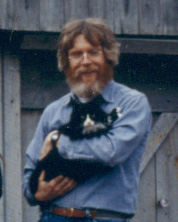 One younger
tree got named Splitter because at the time it was right next to
the log splitter where Steve was splitting most of our firewood that year. The
rest of the trees were named after all the wonderful cats who have lived (and are living)
with us. Each cat has a tree, starting with Mr.C, then Ditto,
Cali, Sasha, and our current LilliBulero, who gets two trees because of her
great personality, her name, and there being two appropriate trees next to each
other in front of the shop, now Lilli and Bulero. One thing they all have in
common is little involvement from me, except for pruning to keep them open and
within reach, and often once or twice clearing underbrush to make it easier for
access. Yet they often have healthy, clean fruit. What a gift they
are!
One younger
tree got named Splitter because at the time it was right next to
the log splitter where Steve was splitting most of our firewood that year. The
rest of the trees were named after all the wonderful cats who have lived (and are living)
with us. Each cat has a tree, starting with Mr.C, then Ditto,
Cali, Sasha, and our current LilliBulero, who gets two trees because of her
great personality, her name, and there being two appropriate trees next to each
other in front of the shop, now Lilli and Bulero. One thing they all have in
common is little involvement from me, except for pruning to keep them open and
within reach, and often once or twice clearing underbrush to make it easier for
access. Yet they often have healthy, clean fruit. What a gift they
are! Cali has fairly recently been set free from nearby
large trees and is finally getting a fair share of sun. With rather common tart
but with flavor medium size fall apples it's not a big producer but nonetheless
adds to the mix. Splitter is similar but with slightly rougher skin and a
bit more flavor, a nice eating apple, ripening in September and keeping well for
a few months. Being near everyday activity it gets much more attention, and I
manage to harvest most of the apples, though I share some with the squirrel,
chipmunk, and deer. Being of a convenient size within easy reach it also got
several grafts of leftover scions when we were done with our regular grafting.
It doesn't seem to mind.
Cali has fairly recently been set free from nearby
large trees and is finally getting a fair share of sun. With rather common tart
but with flavor medium size fall apples it's not a big producer but nonetheless
adds to the mix. Splitter is similar but with slightly rougher skin and a
bit more flavor, a nice eating apple, ripening in September and keeping well for
a few months. Being near everyday activity it gets much more attention, and I
manage to harvest most of the apples, though I share some with the squirrel,
chipmunk, and deer. Being of a convenient size within easy reach it also got
several grafts of leftover scions when we were done with our regular grafting.
It doesn't seem to mind.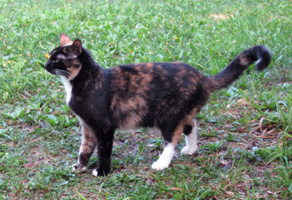 Lilli is a nice tree
with poor apples (not at all like her namesake, our wonderful feline LilliBulero) so I'm grafting most of the tree over to other
varieties, one of which is from a nice fall apple seedling up the road which I
call CowGate. Lilli's companion next door, Bulero, is also a nice tree
but with interesting apples, not at all like Lilli's. The fruit is small, about
2 1/4 inches, dark red, slightly dry skin, slightly juicy flesh, mild, sweet,
somewhat similar to Black Oxford. Not being
Lilli is a nice tree
with poor apples (not at all like her namesake, our wonderful feline LilliBulero) so I'm grafting most of the tree over to other
varieties, one of which is from a nice fall apple seedling up the road which I
call CowGate. Lilli's companion next door, Bulero, is also a nice tree
but with interesting apples, not at all like Lilli's. The fruit is small, about
2 1/4 inches, dark red, slightly dry skin, slightly juicy flesh, mild, sweet,
somewhat similar to Black Oxford. Not being
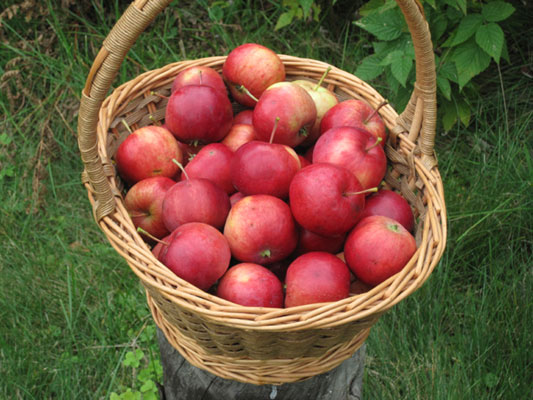 overly impressed with the fruit when
I first noticed it I grafted a Norkent to it in 2017, a vigorous hardy Canadian
variety, planning to pretty much replace the original with the Norkent. But with
a few years of pruning, removing dead and crossed branches, opening up the tree
to more sun, bringing the top down, the fruit has improved a lot. This year (2019) to
my surprise it was better than ever, jucier, more flavor, and made a very good
sauce mixed with the tarter Front Yard fruit. The Norkent graft is growing well
so my plan now is to go for half original, half Norkent tree.
overly impressed with the fruit when
I first noticed it I grafted a Norkent to it in 2017, a vigorous hardy Canadian
variety, planning to pretty much replace the original with the Norkent. But with
a few years of pruning, removing dead and crossed branches, opening up the tree
to more sun, bringing the top down, the fruit has improved a lot. This year (2019) to
my surprise it was better than ever, jucier, more flavor, and made a very good
sauce mixed with the tarter Front Yard fruit. The Norkent graft is growing well
so my plan now is to go for half original, half Norkent tree. 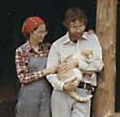 Another
nice surprise was Mr.C.,
for years written off as a tart but good for wildlife 1 1/2" yellow crab. A prolific, tall, gangly, strangly, vigorous
crab tree, it cooperatively hangs over a mowed drive area near the house,
dropping generous amounts of fruit for the easy dining pleasure of deer and
small rodents. I hadn't paid too much attention to the fruit, or the tree,
except to prune low branches to keep them above car height. But a few years ago
I decided to prune out some of the worst of the tangle, opening up the fruit to
more sun, though my purpose originally was simply to make a somewha
Another
nice surprise was Mr.C.,
for years written off as a tart but good for wildlife 1 1/2" yellow crab. A prolific, tall, gangly, strangly, vigorous
crab tree, it cooperatively hangs over a mowed drive area near the house,
dropping generous amounts of fruit for the easy dining pleasure of deer and
small rodents. I hadn't paid too much attention to the fruit, or the tree,
except to prune low branches to keep them above car height. But a few years ago
I decided to prune out some of the worst of the tangle, opening up the fruit to
more sun, though my purpose originally was simply to make a somewha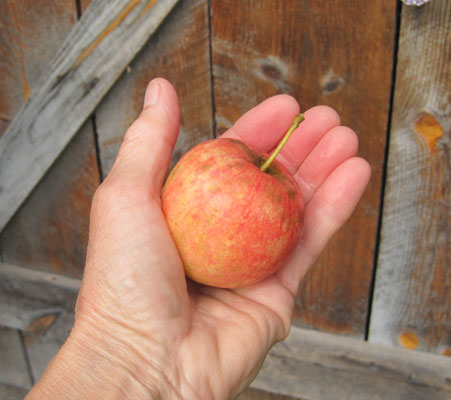 t more
comfortable looking shape without getting too serious about it. It was, after
all, a wildlife tree. But a funny thing happened with the fruit. Last year, a
light year for production, I noticed the apples were streaked with red, they
were larger, and to my surprise quite tasty. Suddenly the tree changed from a crab
for the deer to an interesting tasty attractive lunchbox apple. Was it the
pruning? Or because it was a light crop? Or the weather? Or?? This year (2019)
it was back to full production but the apples were still large (for a crab), 2",
red streaked, tasty in a tart-sweet-flavor-filled way. I picked up and snacked
on many a little apple as I walked by, though I left most for the deer and
critters. I had plenty of other, larger, apples this year, but this one certainly
intrigues me.
t more
comfortable looking shape without getting too serious about it. It was, after
all, a wildlife tree. But a funny thing happened with the fruit. Last year, a
light year for production, I noticed the apples were streaked with red, they
were larger, and to my surprise quite tasty. Suddenly the tree changed from a crab
for the deer to an interesting tasty attractive lunchbox apple. Was it the
pruning? Or because it was a light crop? Or the weather? Or?? This year (2019)
it was back to full production but the apples were still large (for a crab), 2",
red streaked, tasty in a tart-sweet-flavor-filled way. I picked up and snacked
on many a little apple as I walked by, though I left most for the deer and
critters. I had plenty of other, larger, apples this year, but this one certainly
intrigues me.